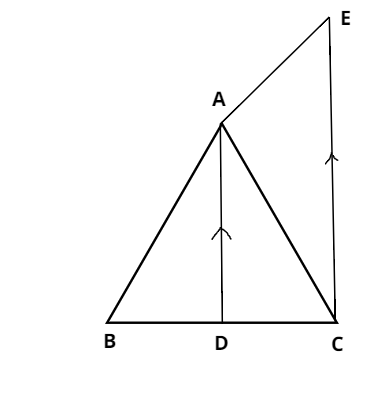
The internal bisector of an angle of a triangle divides the opposite side internally in the ratio of corresponding sides containing angles. Prove it.
Answer
596.7k+ views
Hint: To solve this problem we need to have a basic knowledge about the properties of triangles and Thales theorem and a basic idea about the construction part which helps us to solve the problem in a simple way by using the required theorems.
Complete step-by-step answer:
Let us consider a triangle ABC.
Here AD is the internal bisector of $\angle BAC$ which meets BC at D.
According to the question given
We have to prove that $\dfrac{{BD}}{{DC}} = \dfrac{{AB}}{{AC}}$
Now here let us do a simple construction which helps to prove the above condition.
Construction: Draw $CE\parallel DA$ to meet BA which produces at E.

After the construction part is done, we can say that
$CE\parallel DA$ and AC is the transversal (By construction)
$\angle DAC = \angle ACE - - - - (1)$ (Alternate angles)
$\angle BAD = \angle AEC - - - - - (2)$ (Corresponding angles)
Since AD is the angle bisector of $\angle A$
Therefore we can say that $\angle BAD = \angle DAC - - - - - > (3)$
So from (1) (2) and (3) we say that
$\angle ACE = \angle AEC$
Now from triangle $\Delta ACE$
$ \Rightarrow AE = AC$ (Therefore sides opposite to equal angles are equal)
Again now from triangle BCE
$ \Rightarrow CE\parallel DA$
$ \Rightarrow \dfrac{{BD}}{{DC}} = \dfrac{{BA}}{{AE}}$ (By using Thales theorem)
$ \Rightarrow \dfrac{{BD}}{{DC}} = \dfrac{{AB}}{{AC}}$ (Since we know that AE=AC)
Hence we have proved that the internal bisector of an angle of a triangle divides the opposite side internally in the ratio of corresponding sides containing angles.
NOTE: This question is generally a theorem type question that we have to prove by considering the required concepts. For this type of proof question we have to do required construction to prove the condition. We generally take other theorems to prove the given theorem, in this theorem we have used Thales theorem and some required properties of triangles.
Complete step-by-step answer:
Let us consider a triangle ABC.
Here AD is the internal bisector of $\angle BAC$ which meets BC at D.
According to the question given
We have to prove that $\dfrac{{BD}}{{DC}} = \dfrac{{AB}}{{AC}}$
Now here let us do a simple construction which helps to prove the above condition.
Construction: Draw $CE\parallel DA$ to meet BA which produces at E.

After the construction part is done, we can say that
$CE\parallel DA$ and AC is the transversal (By construction)
$\angle DAC = \angle ACE - - - - (1)$ (Alternate angles)
$\angle BAD = \angle AEC - - - - - (2)$ (Corresponding angles)
Since AD is the angle bisector of $\angle A$
Therefore we can say that $\angle BAD = \angle DAC - - - - - > (3)$
So from (1) (2) and (3) we say that
$\angle ACE = \angle AEC$
Now from triangle $\Delta ACE$
$ \Rightarrow AE = AC$ (Therefore sides opposite to equal angles are equal)
Again now from triangle BCE
$ \Rightarrow CE\parallel DA$
$ \Rightarrow \dfrac{{BD}}{{DC}} = \dfrac{{BA}}{{AE}}$ (By using Thales theorem)
$ \Rightarrow \dfrac{{BD}}{{DC}} = \dfrac{{AB}}{{AC}}$ (Since we know that AE=AC)
Hence we have proved that the internal bisector of an angle of a triangle divides the opposite side internally in the ratio of corresponding sides containing angles.
NOTE: This question is generally a theorem type question that we have to prove by considering the required concepts. For this type of proof question we have to do required construction to prove the condition. We generally take other theorems to prove the given theorem, in this theorem we have used Thales theorem and some required properties of triangles.
Recently Updated Pages
Two men on either side of the cliff 90m height observe class 10 maths CBSE

What happens to glucose which enters nephron along class 10 biology CBSE

Cutting of the Chinese melon means A The business and class 10 social science CBSE

Write a dialogue with at least ten utterances between class 10 english CBSE

Show an aquatic food chain using the following organisms class 10 biology CBSE

A circle is inscribed in an equilateral triangle and class 10 maths CBSE

Trending doubts
Why is there a time difference of about 5 hours between class 10 social science CBSE

Write a letter to the principal requesting him to grant class 10 english CBSE

What is the median of the first 10 natural numbers class 10 maths CBSE

The Equation xxx + 2 is Satisfied when x is Equal to Class 10 Maths

Which of the following does not have a fundamental class 10 physics CBSE

State and prove converse of BPT Basic Proportionality class 10 maths CBSE




